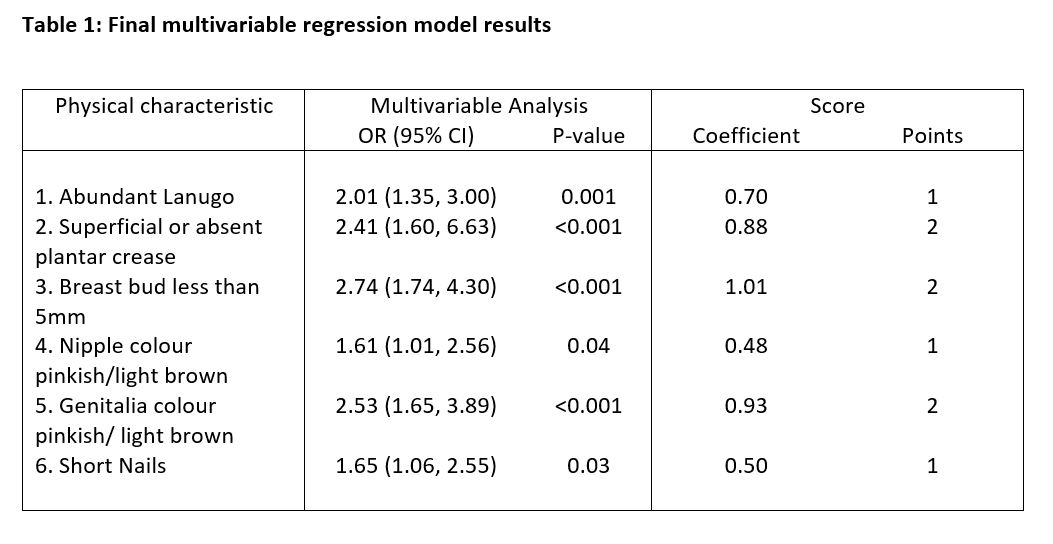Neonatal General
Category: Abstract Submission
Neonatology General 3
373 - Development and validation of a physical maturity score identifying late preterm infants in low- and middle-income countries
Friday, April 22, 2022
6:15 PM - 8:45 PM US MT
Poster Number: 373
Publication Number: 373.133
Publication Number: 373.133
Vaisakh Krishnan, Imperial College, London, PALAKKAD, Kerala, India; Vijay Kumar, Imperial college london, London, England, United Kingdom; Hemadriben M. Vegda, International Perinatal Epidemiology Unit Private Limited, Bengaluru, Karnataka, India; Vidya Ujjanappa, IPEU, Hubli, Karnataka, India; Anju M, IMCH, Calicut, Kerala, India; Ajithkumar Vellani Thamunni, Govt medical college kozhikode, Kozhikode, Kerala, India; Ashraf Thottoli Puthyapurayil, Government Medical College Kozhikode, kozhikode, Kerala, India; Sahana Devadas, Vanivillas children's hospital, Bengaluru, Karnataka, India; Sudhindrashayana R. Fattepur, Karnataka Institute of Medical Sciences, Hubballi, Dharwad, Karnataka, India; Sudhin Thayyil, Imperial College London, London, England, United Kingdom

Vaisakh Krishnan, MD, DNB, MRCPCH (he/him/his)
Neonatal neurology clinical research fellow
Imperial College, London
Palakkad, Kerala, India
Presenting Author(s)
Background: Although identifying late preterm from term babies is important to guide clinical care, currently available scoring systems which involve neurological criteria are too complex for use in low- and middle-income countries (LMIC), and those relying on physical characteristics alone perform poorly when tested in community settings(Lee et al, 2016).
Objective: To develop and validate a scoring system based on easily identifiable physical characteristics for identifying late preterm infants from term infants in South India.
Design/Methods: We conducted a prospective observational study recruiting 2010 infants born at or after 35 weeks between October 2020 and August 2021 at three tertiary neonatal units in south India. In the first phase (discovery cohort; n=1006), the accuracy of 10 objective physical characteristics was examined. We identified the best performing characteristics using multiple regression analysis and developed a weighted scoring system and clinical photo cards for easy use. The optimized scoring system was then validated in another 1004 babies (validation cohort) by obstetric and neonatal nurses.
Results: Of the 1006 babies in the discovery cohort, data on 928 infants were analyzed. Although all 10 components were associated with prematurity on univariate analysis (p < 0.001), only six showed a significant association on multiple logistic regression analysis (Table. 1). These were lanugo hairs (p=0.001), plantar crease (p= < 0.001), breast bud (p= < 0.001), nipple colour (p=0.04), genitalia colour (p= < 0.001), and nail size (p=0.03). The final optimized and weighted score (figure. 1) was tested in a validation cohort of 1004 babies, of which 977 were analyzed. A score of 4 or more had a sensitivity of 66.7%, specificity of 80.0%, and a negative predictive value of 92.7% for identifying late preterm infants from term infants (Table 2).Conclusion(s): Our new gestational assessment scoring system consisting of six easy-to-identify physical characteristics can accurately identify late preterm infants from term infants and has wider applicability in community settings and for assessing infants with neonatal encephalopathy as this does not require any neurological assessment.
CV- VK 2021-converted.pdf
Table 1: Final multivariable regression model results
Objective: To develop and validate a scoring system based on easily identifiable physical characteristics for identifying late preterm infants from term infants in South India.
Design/Methods: We conducted a prospective observational study recruiting 2010 infants born at or after 35 weeks between October 2020 and August 2021 at three tertiary neonatal units in south India. In the first phase (discovery cohort; n=1006), the accuracy of 10 objective physical characteristics was examined. We identified the best performing characteristics using multiple regression analysis and developed a weighted scoring system and clinical photo cards for easy use. The optimized scoring system was then validated in another 1004 babies (validation cohort) by obstetric and neonatal nurses.
Results: Of the 1006 babies in the discovery cohort, data on 928 infants were analyzed. Although all 10 components were associated with prematurity on univariate analysis (p < 0.001), only six showed a significant association on multiple logistic regression analysis (Table. 1). These were lanugo hairs (p=0.001), plantar crease (p= < 0.001), breast bud (p= < 0.001), nipple colour (p=0.04), genitalia colour (p= < 0.001), and nail size (p=0.03). The final optimized and weighted score (figure. 1) was tested in a validation cohort of 1004 babies, of which 977 were analyzed. A score of 4 or more had a sensitivity of 66.7%, specificity of 80.0%, and a negative predictive value of 92.7% for identifying late preterm infants from term infants (Table 2).Conclusion(s): Our new gestational assessment scoring system consisting of six easy-to-identify physical characteristics can accurately identify late preterm infants from term infants and has wider applicability in community settings and for assessing infants with neonatal encephalopathy as this does not require any neurological assessment.
CV- VK 2021-converted.pdf
Table 1: Final multivariable regression model results

